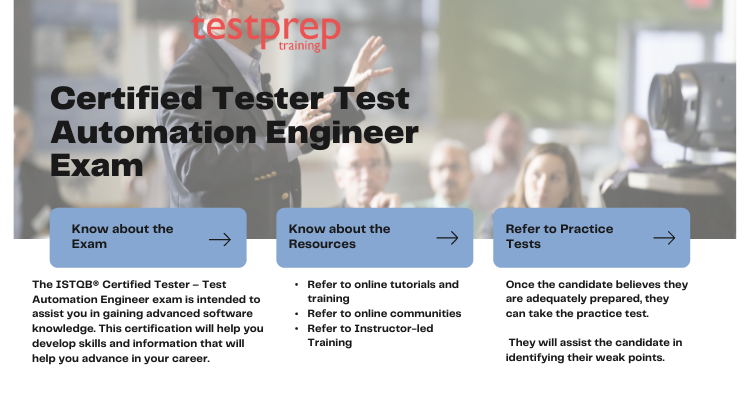The Certified Tester Test Automation Engineer (CT-TAE) exam is a globally recognized certification exam for professionals who are involved in test automation. The exam is designed to test the knowledge, skills, and abilities of candidates in test automation design and architecture, test automation strategies and approaches, test automation tools and frameworks, and scripting and programming concepts.
Test automation is and will remain a popular career path for professionals. It is predicted that by 2023, one out of every three people in the workforce will be involved in some form of test automation or test code writing. For many people in this rapidly expanding industry, it has become a lucrative and rewarding career. This is especially true for recent graduates with degrees in computer science and software engineering, who can easily find high-paying jobs in this field.
To prepare for the CT-TAE exam, candidates should have a solid understanding of test automation concepts and techniques, as well as experience in using test automation tools and frameworks. Candidates should also be familiar with programming concepts and have experience in writing scripts and test automation code.
Overall, the CT-TAE exam is a challenging but rewarding certification that can help professionals advance their careers in the software testing industry.
What is the ISTQB Certified Tester Test Automation Engineer (CT-TAE) Exam?
The ISTQB® Certified Tester – Test Automation Engineer exam is intended to assist you in gaining advanced software knowledge. This certification will help you develop skills and information that will help you advance in your career. You will gain in-depth knowledge and understanding of subjects.
Exam Prerequisites: To sit for the ISTQB Certified Tester Test Automation Engineer certification exam, you must first hold the ISTQB Foundation Level certificate [ISTQB-CTFL].
Let us now jump to the main point –
How to pass the Certified Tester Test Automation Engineer (CT-TAE) Exam?
Take a look at the following steps that must be completed in order to qualify for the exam, and pay close attention to them:

Step 1 – Know in-depth about the Exam Syllabus
The updated course outline is –
1. Introduction and Objectives for Test Automation
- Purpose of Test Automation
- ALTA-E-1.1.1 (K2) Explain the objectives, advantages, disadvantages, and limitations of test automation
- Success Factors in Test Automation
- also, ALTA-E-1.2.1 (K2) Identify technical success factors of a test automation project
2. Preparing for Test Automation
- SUT Factors Influencing Test Automation
- ALTA-E-2.1.1 (K4) Analyze a system under test to determine the appropriate automation solution
- Tool Evaluation and Selection
- also, ALTA-E-2.2.1 (K4) Analyze test automation tools for a given project and report technical findings and recommendations
- 2.3 Design for Testability and Automation
- furthermore, ALTA-E-2.3.1 (K2) Understand “design for testability” and “design for test automation” methods applicable to the SUT
3. The Generic Test Automation Architecture
- Introduction to gTAA
- ALTA-E-3.1.1 (K2) Explain the structure of the gTAA
- TAA Design
- ALTA-E-3.2.1 (K4) Design the appropriate TAA for a given project
- also, ALTA-E-3.2.2 (K2) Explain the role that layers play within a TAA
- furthermore, ALTA-E-3.2.3 (K2) Understand design considerations for a TAA
- moreover, ALTA-E-3.2.4 (K4) Analyze factors of implementation, use, and maintenance requirements for a given TAS
- TAS Development
- ALTA-E-3.3.1 (K3) Apply components of the generic TAA (gTAA) to construct a purpose-built TAA
- moreover, ALTA-E-3.3.2 (K2) Explain the factors to be considered when identifying the reusability of components
4. Deployment Risks and Contingencies
- Selection of Test Automation Approach and Planning of Deployment/Rollout
- ALTA-E-4.1.1 (K3) Apply guidelines that support effective test tool pilot and deployment activities
- Risk Assessment and Mitigation Strategies
- also, ALTA-E-4.2.1 (K4) Analyze deployment risks and identify technical issues that could lead to failure of the test automation project, and plan mitigation strategies
- Test Automation Maintenance
- also, ALTA-E-4.3.1 (K2) Understand which factors support and affect TAS maintainability
5. Test Automation Reporting and Metrics
- Selection of TAS Metrics
- ALTA-E-5.1.1 (K2) Classify metrics that can be used to monitor the test automation strategy and effectiveness
- Implementation of Measurement
- also, ALTA-E-5.2.1 (K3) Implement metrics collection methods to support technical and management requirements. Explain how the measurement of the test automation can be implemented.
- Logging of the TAS and the SUT
- also, ALTA-E-5.3.1 (K4) Analyze test logging of both TAS and SUT data
- Test Automation Reporting
- also, ALTA-E-5.4.1 (K2) Explain how a test execution report is constructed and published
6. Transitioning Manual Testing to an Automated Environment
- Criteria for Automation
- ALTA-E-6.1.1 (K3) Apply criteria for determining the suitability of tests for automation
- also, ALTA-E-6.1.2 (K2) Understand the factors in transitioning from manual to automation testing
- Identify Steps Needed to Implement Automation within Regression Testing
- also, ALTA-E-6.2.1 (K2) Explain the factors to consider in implementing automated regression testing
- Factors to Consider when Implementing Automation within New Feature Testing
- also, ALTA-E-6.3.1 (K2) Explain the factors to consider in implementing automation within new feature testing
- Factors to Consider when Implementing Automation of Confirmation Testing
- also, ALTA-E-6.4.1 (K2) Explain the factors to consider in implementing automated confirmation testing
7. Verifying the TAS
- Verifying Automated Test Environment Components
- ALTA-E-7.1.1 (K3) Verify the correctness of an automated test environment including test tool setup
- Verifying the Automated Test Suite
- ALTA-E-7.2.1 (K3) Verify the correct behavior for a given automated test script and/or test suite
8. Continuous Improvement
- Options for Improving Test Automation
- also, ALTA-E-8.1.1 (K4) Analyze the technical aspects of a deployed test automation solution and provide recommendations for improvement
- Adapting Test Automation to the environment and SUT changes
- furthermore, ALTA-E-8.2.1 (K4) Analyze the automated testware, including test environment components, tools, and supporting function libraries, in order to understand where consolidation and updates should be made following a given set of test environment or SUT changes
Step 2 – Know about the Exam Format
The ISTQB® Certified Tester – Test Automation Engineer examination has a time limit of 90 minutes to complete. You must complete 40 ISTQB Certified Tester Test Automation Engineer Exam Questions. Moreover, This exam will also cost you around $229. Furthermore, the exam rescheduling fee is $90.
Step 3 – Refer to the Exam Resources
The knowledge and comprehension levels of various resources vary. In academic life, however, revision should be done on a case-by-case basis. Let’s take a look at the resources that are available –
Books
It is critical to use the appropriate resources to prepare for the ISTQB® Certified Tester – Test Automation Engineer examination. The ISTQB provides sample papers and questions to help you prepare for the exam. In addition, we have provided some reference ISTQB Test Automation Engineer Books to help you prepare:
- Test Automation Engineer: Guide to the Istqb Advanced Level Certification by Andrew L Pollner (Author), Mark Fewster (Author)
Join a Community
A lively debate, no matter where it takes place, is always beneficial. The same can be said for online message boards. This is a fantastic opportunity for students to voice their concerns and observe how their peers are preparing for exams. The large number of people who can participate in anything available online is one of its advantages. The research becomes more extensive as a result of these discussions. Introverts, who may normally avoid social situations, are given the opportunity to express themselves. Forums are fantastic for creating the community needed to understand others.
Practice Tests
It is critical to practice what you have learned so that you can analyze your practice. By practicing, you will be able to improve your answering skills, which will save you a lot of time. Furthermore, the best time to begin doing practice tests is after you have completed one full topic, as this will serve as a revision component for you. So, get started right away with free ISTQB Certified Tester Test Automation Engineer Practice Tests!


